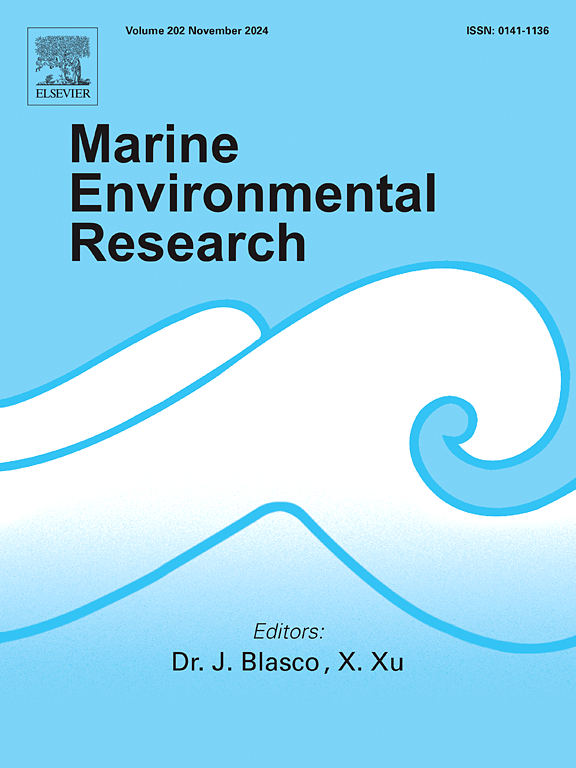木坪海洋牧场夏季海水酸化解译:pH与文石饱和状态
IF 3
3区 环境科学与生态学
Q2 ENVIRONMENTAL SCIENCES
引用次数: 0
摘要
沿海季节性酸化严重影响了海洋水产养殖,特别是贝类养殖。然而,不同的养殖条件下,控制海水酸化的因素有所不同。本研究于2022年6 - 7月对中国典型贝类养殖场进行了夏季游船考察,分析了海水pH和文石饱和状态的时空分布(Ωarag),以及它们对温度、海气CO2交换、混合、CaCO3形成/溶解和生物效应的响应。底层海水pH值和Ωarag值均低于表层海水,表层和底层海水pH值分别为8.02 ~ 8.09和7.87 ~ 8.02,Ωarag值分别为2.80 ~ 3.80和2.21 ~ 2.43。海底海水pH值和Ωarag均呈下降趋势,个别站点的Ωarag接近或低于2。生物(表层海水:51%±4%;底层海水:−39%±8%)和温度(表层海水:−28%±6%;底层海水:−41%±8%)效应对海水ph的调节至关重要。在表层海水(64%±7%)和底层海水(−48%±9%)中,生物效应是Ωarag变化的主要因素。此外,底部海水中碳酸钙的溶解对Ωarag的增加也有一定的贡献(15%±27%)。Ωarag较好地反映了非温度过程(如CaCO3的形成/溶解和生物效应)的影响。本研究主张Ωarag作为沿海水产养殖区海水酸化更合适的指标。本文章由计算机程序翻译,如有差异,请以英文原文为准。
Deciphering seawater acidification in the Muping Marine Ranch in summer: pH vs. aragonite saturation state
Coastal seasonal acidification has severely impacted marine aquaculture, particularly shellfish farming. However, factors controlling seawater acidification vary in different aquaculture conditions. This study conducted summer cruises of a typical shellfish farming in China, from June to July 2022 to analyze the spatiotemporal distributions of seawater pH and aragonite saturation state (Ωarag), and their response to temperature, sea-air CO2 exchange, mixing, CaCO3 formation/dissolution, and biological effects. The pH and Ωarag of bottom seawater were both lower than surface seawater, with the pH of surface and bottom seawater ranging from 8.02 to 8.09 and 7.87 to 8.02, while the Ωarag ranging from 2.80 to 3.80 and 2.21 to 2.43, respectively. The bottom seawater pH and Ωarag both show a decreasing trend, with Ωarag at certain stations close to or below 2. Biological (surface seawater: 51 % ± 4 %; bottom seawater: −39 % ± 8 %) and temperature (surface seawater: −28 % ± 6 %; bottom seawater: −41 % ± 8 %) effects were crucial on regulation of seawater pH. Biological effects were the dominant factor in the variation of Ωarag in both the surface (64 % ± 7 %) and bottom (−48 % ± 9 %) seawater. Additionally, the dissolution of calcium carbonate in bottom seawater contributed to an increase in Ωarag to some extent (15 % ± 27 %). Ωarag better reflects the influence of non-temperature processes (e.g., CaCO3 formation/dissolution and biological effects). This study advocates for Ωarag as a more suitable indicator of seawater acidification in coastal aquaculture areas.
求助全文
通过发布文献求助,成功后即可免费获取论文全文。
去求助
来源期刊

Marine environmental research
环境科学-毒理学
CiteScore
5.90
自引率
3.00%
发文量
217
审稿时长
46 days
期刊介绍:
Marine Environmental Research publishes original research papers on chemical, physical, and biological interactions in the oceans and coastal waters. The journal serves as a forum for new information on biology, chemistry, and toxicology and syntheses that advance understanding of marine environmental processes.
Submission of multidisciplinary studies is encouraged. Studies that utilize experimental approaches to clarify the roles of anthropogenic and natural causes of changes in marine ecosystems are especially welcome, as are those studies that represent new developments of a theoretical or conceptual aspect of marine science. All papers published in this journal are reviewed by qualified peers prior to acceptance and publication. Examples of topics considered to be appropriate for the journal include, but are not limited to, the following:
– The extent, persistence, and consequences of change and the recovery from such change in natural marine systems
– The biochemical, physiological, and ecological consequences of contaminants to marine organisms and ecosystems
– The biogeochemistry of naturally occurring and anthropogenic substances
– Models that describe and predict the above processes
– Monitoring studies, to the extent that their results provide new information on functional processes
– Methodological papers describing improved quantitative techniques for the marine sciences.
 求助内容:
求助内容: 应助结果提醒方式:
应助结果提醒方式:


